Fortical
FORTICAL calcitonin-salmon (rDNA origin) Nasal Spray
FULL PRESCRIBING INFORMATION: CONTENTS*
- FORTICAL DESCRIPTION
- CLINICAL PHARMACOLOGY
- FORTICAL INDICATIONS AND USAGE
- FORTICAL CONTRAINDICATIONS
- WARNINGS
- PRECAUTIONS
- FORTICAL ADVERSE REACTIONS
- OVERDOSAGE
- FORTICAL DOSAGE AND ADMINISTRATION
- HOW SUPPLIED
- Forticalcalcitonin-salmon (rDNA origin)Nasal Spray
- PRINCIPAL DISPLAY PANEL - 2200 IU/mL Carton
FULL PRESCRIBING INFORMATION
For Intranasal Use Only
Rx only
FORTICAL DESCRIPTION
Calcitonin is a polypeptide hormone secreted by the parafollicular cells of the thyroid gland in mammals and by the ultimobranchial gland of birds and fish.
The active ingredient in FORTICAL® calcitonin-salmon (rDNA origin) Nasal Spray is a polypeptide of 32 amino acids manufactured by recombinant DNA technology and is identical to calcitonin-salmon produced by chemical synthesis.
This is shown by the following graphic formula:
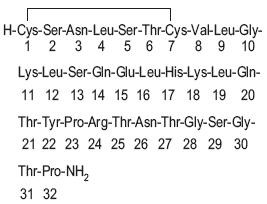
It is provided in a 3.7 mL fill glass bottle as a solution for intranasal administration with sufficient medication for at least 30 doses. Each spray delivers 200 International Units calcitonin-salmon in a volume of 0.09 mL.
Active Ingredient: Calcitonin-salmon 2200 International Units/mL, corresponding to 200 International Units per actuation (0.09 mL).
Inactive Ingredients: Sodium Chloride USP, Citric Acid USP, Phenylethyl Alcohol USP, Benzyl Alcohol NF, Polysorbate 80 NF, Hydrochloric Acid NF or Sodium Hydroxide NF (added as necessary to adjust pH) and Purified Water USP.
CLINICAL PHARMACOLOGY
Calcitonin acts primarily on bone, but direct renal effects and actions on the gastrointestinal tract are also recognized. Calcitonin-salmon appears to have actions essentially identical to calcitonins of mammalian origin, but its potency per mg is greater and it has a longer duration of action.
The information below, describing the clinical pharmacology of calcitonin, has been derived from studies with injectable calcitonin. The mean bioavailability of calcitonin-salmon nasal spray is approximately 3% of the injectable calcitonin in normal subjects and, therefore, the conclusions concerning the CLINICAL PHARMACOLOGY of this preparation may be different.
The actions of calcitonin on bone and its role in normal human bone physiology are still not completely elucidated, although calcitonin receptors have been discovered in osteoclasts and osteoblasts.
Single injections of calcitonin cause a marked transient inhibition of the ongoing bone resorptive process. With prolonged use, there is a persistent, smaller decrease in the rate of bone resorption. Histologically, this is associated with a decreased number of osteoclasts and an apparent decrease in their resorptive activity. In vitro studies have shown that calcitonin-salmon causes inhibition of osteoclast function with loss of the ruffled osteoclast border responsible for resorption of bone. This activity resumes following removal of calcitonin-salmon from the test system. There is some evidence from in vitro studies that bone formation may be augmented by calcitonin through increased osteoblastic activity.
Animal studies indicate that endogenous calcitonin, primarily through its action on bone, participates with parathyroid hormone in the homeostatic regulation of blood calcium. Thus, high blood calcium levels cause increased secretion of calcitonin which, in turn, inhibits bone resorption. This reduces the transfer of calcium from bone to blood and tends to return blood calcium towards the normal level. The importance of this process in humans has not been determined. In normal adults, who have a relatively low rate of bone resorption, the administration of exogenous calcitonin results in only a slight decrease in serum calcium in the limits of the normal range. In normal children and in patients with Paget's disease in whom bone resorption is more rapid, decreases in serum calcium are more pronounced in response to calcitonin.
Bone biopsy and radial bone mass studies at baseline and after 26 months of daily injectable calcitonin indicate that calcitonin therapy results in the formation of normal bone.
Postmenopausal Osteoporosis
Osteoporosis is a disease characterized by low bone mass and architectural deterioration of bone tissue leading to enhanced bone fragility and a consequent increase in fracture risk as patients approach or fall below a bone mineral density associated with increased frequency of fracture. The most common type of osteoporosis occurs in postmenopausal women. Osteoporosis is a result of a disproportionate rate of bone resorption compared to bone formation, which disrupts the structural integrity of bone, rendering it more susceptible to fracture. The most common sites of these fractures are the vertebrae, hip, and distal forearm (Colles' fracture). Vertebral fractures occur with the highest frequency and are associated with back pain, spinal deformity and a loss of height.
Calcitonin, given by the intranasal route, has been shown to increase spinal bone mass in postmenopausal women with established osteoporosis but not in early postmenopausal women.
Calcium Homeostasis
In two clinical studies designed to evaluate the pharmacodynamic response to calcitonin-salmon nasal spray, administration of 100-1600 International Units to healthy volunteers resulted in rapid and sustained small decreases (but still within the normal range) in both total serum calcium and serum ionized calcium. Single doses greater than 400 International Units did not produce any further biological response to the drug. The development of hypocalcemia has not been reported in studies in healthy volunteers or postmenopausal women.
Kidney
Studies with injectable calcitonin show increases in the excretion of filtered phosphate, calcium, and sodium by decreasing their tubular reabsorption. Comparable studies have not been conducted with FORTICAL® calcitonin-salmon (rDNA origin) Nasal Spray.
Gastrointestinal Tract
Some evidence from studies with injectable preparations suggests that calcitonin may have significant actions on the gastrointestinal tract. Short-term administration of injectable calcitonin results in marked transient decreases in the volume and acidity of gastric juice and in the volume and the trypsin and amylase content of pancreatic juice. Whether these effects continue to be elicited after each injection of calcitonin during chronic therapy has not been investigated. These studies have not been conducted with FORTICAL® calcitonin-salmon (rDNA origin) Nasal Spray.
Pharmacokinetics and Drug Metabolism
The pharmacokinetic properties of FORTICAL® calcitonin-salmon (rDNA origin) Nasal Spray after multiple dose administration were shown to be similar to that of a commercially available calcitonin-salmon product in healthy volunteers. The bioavailability of calcitonin-salmon nasal spray relative to intramuscular administration is between 3 and 5%. Calcitonin-salmon nasal spray is absorbed by the nasal mucosa with a mean Tmax of about 13 minutes. The terminal half-life of calcitonin-salmon has been calculated to be around 18 minutes and no evidence of accumulation was observed with multiple dosing. Plasma exposure was higher following administration of 400 IU nasal spray compared to that after 200 IU dose. As is the case with other polypeptide hormones, there is very little value in monitoring plasma levels of salmon calcitonin since these are not directly predictive of the therapeutic response. Hence, Fortical® activity should be evaluated by using clinical parameters of efficacy.
FORTICAL INDICATIONS AND USAGE
Postmenopausal Osteoporosis
FORTICAL® calcitonin-salmon (rDNA origin) Nasal Spray is indicated for the treatment of postmenopausal osteoporosis in women greater than 5 years postmenopause with low bone mass relative to healthy premenopausal women. Use of FORTICAL® calcitonin-salmon (rDNA origin) Nasal Spray is recommended in conjunction with an adequate calcium (at least 1000 mg elemental calcium per day) and Vitamin D (400 International Units per day) intake to retard the progressive loss of bone mass. The evidence of efficacy for calcitonin-salmon is based on increases in spinal bone mineral density (BMD) observed in clinical trials.
Two randomized, placebo-controlled trials were conducted in 325 postmenopausal women (227 treated with calcitonin-salmon nasal spray and 98 treated with placebo) with spinal, forearm or femoral BMD at least one standard deviation below the normal value for healthy premenopausal women. These studies conducted over two years demonstrated that 200 International Units daily of calcitonin-salmon nasal spray increases lumbar vertebral BMD relative to baseline and relative to placebo in osteoporotic women who were greater than 5 years postmenopause. Calcitonin-salmon nasal spray produced statistically significant increases in lumbar vertebral BMD compared to placebo as early as 6 months after initiation of therapy with persistence of this level for up to 2 years of observation.
No effects of calcitonin-salmon nasal spray on cortical bone of the forearm or hip were demonstrated. However, in one study, BMD of the hip showed a statistically significant increase compared with placebo in a region composed of predominantly trabecular bone after 1 year of treatment changing to a trend at 2 years that was no longer statistically significant.
FORTICAL CONTRAINDICATIONS
Clinical allergy to calcitonin-salmon.
WARNINGS
Allergic Reactions
Because calcitonin is a polypeptide, the possibility of a systemic allergic reaction exists. A few cases of serious allergic-type reactions have been reported in patients receiving calcitonin-salmon nasal spray, including cases of anaphylaxis and anaphylactic shock. With injectable calcitonin-salmon there have been a few reports of serious allergic-type reactions (e.g. bronchospasm, swelling of the tongue or throat, anaphylactic shock), including very rare reports of death attributed to anaphylaxis. The usual provisions should be made for emergency treatment if such a reaction should occur. Allergic reactions should be differentiated from generalized flushing and hypotension.
For patients with suspected sensitivity to calcitonin, skin testing should be considered prior to treatment utilizing a dilute, sterile solution of a calcitonin-salmon injectable product. Physicians may wish to refer patients who require skin testing to an allergist. A detailed skin testing protocol is available from Upsher-Smith Laboratories, Inc. by calling toll-free at 1-800-654-2299.
PRECAUTIONS
1. Drug Interactions
Formal studies designed to evaluate drug interactions with calcitonin-salmon have not been done.
Concomitant use of calcitonin and lithium may lead to a reduction in plasma lithium concentrations due to increased urinary clearance of lithium. The dose of lithium may need to be adjusted.
The effects of prior use of diphosphonates in postmenopausal osteoporosis patients have not been assessed; however, in patients with Paget's disease prior diphosphonate use appears to reduce the anti-resorptive response to calcitonin-salmon nasal spray.
2. Periodic Nasal Examinations
Periodic nasal examinations with visualization of the nasal mucosa, turbinates, septum and mucosal blood vessel status are recommended.
The development of mucosal alterations or transient nasal conditions have been reported in up to 9% of patients who received a calcitonin-salmon nasal spray and in up to 12% of patients who received placebo nasal spray in studies in postmenopausal women. The majority of patients (approximately 90%) in whom nasal abnormalities were noted also reported nasally related complaints/symptoms as adverse events. Therefore, a nasal examination should be performed prior to start of treatment with nasal calcitonin and at any time nasal complaints occur.
In all postmenopausal patients treated with a calcitonin-salmon nasal spray, the most commonly reported nasal adverse events included rhinitis (12%), epistaxis (3.5%), and sinusitis (2.3%). Smoking was shown not to have any contributory effect on the occurrence of nasal adverse events. One patient (0.3%) treated with a calcitonin-salmon nasal spray who was receiving 400 International Units daily developed a small nasal wound. In clinical trials in another disorder (Paget's disease), 2.8% of patients developed nasal ulcerations.
If severe ulceration of the nasal mucosa occurs, as indicated by ulcers greater than 1.5 mm in diameter or penetrating below the mucosa, or those associated with heavy bleeding, calcitonin-salmon nasal spray should be discontinued. Although smaller ulcers often heal without withdrawal of calcitonin-salmon nasal spray, medication should be discontinued temporarily until healing occurs.
3. Information for Patients
Careful instructions on pump assembly, priming of the pump and nasal introduction of FORTICAL® calcitonin-salmon (rDNA origin) Nasal Spray should be given to the patient. Although instructions for patients are supplied with the individual bottle, procedures for use should be demonstrated to each patient. Patients should notify their physician if they develop significant nasal irritation.
Get emergency medical help right away if you have any of the following symptoms of a serious allergic reaction:
- trouble breathing
- swelling of your face, throat or tongue
- rapid heartbeat
- chest pain
- feel faint or dizzy
Patients should be advised of the following:
- Store new, unassembled bottles in the refrigerator between 36-46°F (2-8°C).
- Protect the product from freezing.
- Keep the bottle of Fortical® Nasal Spray away from light.
- Before priming the pump and using a new bottle, allow it to reach room temperature.
- After opening a new bottle of Fortical® Nasal Spray, store bottle in use with pump attached at room temperature, 68°F to 77°F (20°C to 25°C), in an upright position. Each bottle contains enough medicine for 30 doses.
- Throw away the empty bottle of Fortical® Nasal Spray after you have used 30 doses.
- See DOSAGE AND ADMINISTRATION, Priming (Activation) of Pump for complete instructions on priming the pump and administering FORTICAL® calcitonin-salmon (rDNA origin) Nasal Spray.
4. Carcinogenicity, Mutagenicity, Impairment of Fertility
An increased incidence of non-functioning pituitary adenomas has been observed in 1-year toxicity studies in Sprague-Dawley and Fischer 344 Rats administered (subcutaneously) calcitonin-salmon at dosages of 80 International Units per kilogram per day (16-19 times the recommended human parenteral dose and about 130-160 times the human intranasal dose based on body surface area).
The findings suggest that calcitonin-salmon reduced the latency period for development of the pituitary adenomas that do not produce hormones, probably through the perturbation of physiologic processes involved in the evolution of this commonly occurring endocrine lesion in the rat. Although administration of calcitonin-salmon reduces the latency period of the development of nonfunctional proliferative lesions in rats, it did not induce the hyperplastic/neoplastic process.
Calcitonin-salmon was tested for mutagenicity using four strains of Salmonella typhimurium and two strains of Escherichia coli, with and without rat liver metabolic activation, and found to be non-mutagenic. The drug was also not mutagenic in a chromosome aberration test in Chinese Hamster ovary cells in vitro.
5. Laboratory Tests
Urine sediment abnormalities have not been reported in ambulatory volunteers treated with calcitonin-salmon nasal spray. Coarse granular casts containing renal tubular epithelial cells were reported in young adult volunteers at bed rest who were given injectable calcitonin-salmon to study the effect of immobilization on osteoporosis. There was no evidence of renal abnormality and the urine sediment became normal after calcitonin was stopped. Periodic examinations of urine sediment should be considered.
6. Pregnancy
Teratogenic Effects
Category C
Calcitonin-salmon has been shown to cause a decrease in fetal birth weights in rabbits when given by injection in doses 8-33 times the parenteral dose and 70-278 times the intranasal dose recommended for human use based on body surface area.
Since calcitonin does not cross the placental barrier, this finding may be due to metabolic effects on the pregnant animal. There are no adequate and well-controlled studies in pregnant women with calcitonin-salmon. FORTICAL® calcitonin-salmon (rDNA origin) Nasal Spray is not indicated for use in pregnancy.
7. Nursing Mothers
It is not known whether this drug is excreted in human milk. As a general rule, nursing should not be undertaken while a patient is on this drug since many drugs are excreted in human milk. Calcitonin has been shown to inhibit lactation in animals.
8. Pediatric Use
There are no data to support the use of FORTICAL® calcitonin-salmon (rDNA origin) Nasal Spray in children. Disorders of bone in children referred to as idiopathic juvenile osteoporosis have been reported rarely. The relationship of these disorders to postmenopausal osteoporosis has not been established and experience with the use of calcitonin in these disorders is limited.
9. Geriatric Use
In a large multi-centered, double-blind, randomized clinical study of calcitonin-salmon nasal spray, 279 patients were less than 65 years old, while 467 patients were 65 to 74 years old and 196 patients were 75 and over. Compared to subjects less than 65 years old, the incidence of nasal adverse events (rhinitis, irritation, erythema, and excoriation) was higher in patients over the age of 65, particularly those over the age of 75. Most events were mild in intensity. Other reported clinical experience has not identified differences in responses between the elderly and younger patients, but greater sensitivity of some older individuals cannot be ruled out.
FORTICAL ADVERSE REACTIONS
The incidence of adverse reactions reported in studies involving postmenopausal osteoporotic patients chronically exposed to calcitonin-salmon nasal spray (N=341) and to placebo nasal spray (N=131), and reported in greater than 3% of calcitonin-salmon nasal spray treated patients are presented in the following table. Most adverse reactions were mild to moderate in severity. Nasal adverse events were most common with 70% mild, 25% moderate, and 5% severe in nature (placebo rates were 71% mild, 27% moderate, and 2% severe).
| Adverse Reaction | Calcitonin-Salmon Nasal Spray N=341 % of Patients |
Placebo N=131 % of Patients |
|---|---|---|
| Rhinitis | 12.0 | 6.9 |
| Symptom of Nose |
10.6 | 16.0 |
| Back Pain | 5.0 | 2.3 |
| Arthralgia | 3.8 | 5.3 |
| Epistaxis | 3.5 | 4.6 |
| Headache | 3.2 | 4.6 |
In addition, the following adverse events were reported in fewer than 3% of patients during chronic therapy with calcitonin-salmon nasal spray. Adverse events reported in 1%-3% of patients are identified with an asterisk(*). The remainder occurred in less than 1% of patients. Other than flushing, nausea, possible allergic reactions, and possible local irritative effects in the respiratory tract, a relationship to calcitonin-salmon nasal spray has not been established.
Body as a whole – General Disorders: influenza-like symptoms*, fatigue*, edema (facial, peripheral, and generalized), fever
Integumentary: erythematous rash*, skin ulceration, eczema, alopecia, pruritus, increased sweating
Musculoskeletal/Collagen: arthrosis*, myalgia*, arthritis, polymyalgia rheumatica, stiffness
Respiratory/Special Senses: sinusitis*, upper respiratory tract infection*, bronchospasm*, pharyngitis, bronchitis, pneumonia, coughing, dyspnea, taste perversion, parosmia, nasal congestion, sneezing, allergic rhinitis, nasal odor, mucosal excoriation, rhinitis ulcerative
Cardiovascular: hypertension*, angina pectoris*, tachycardia, palpitation, bundle branch block, myocardial infarction
Gastrointestinal: dyspepsia*, constipation*, abdominal pain*, nausea*, diarrhea*, vomiting, flatulence, increased appetite, gastritis, dry mouth
Liver/Metabolic: cholelithiasis, hepatitis, thirst, weight increase
Endocrine: goiter, hyperthyroidism
Urinary System: cystitis*, pyelonephritis, hematuria, renal calculus
Central and Peripheral Nervous System: dizziness*, paresthesia*, vertigo, migraine, neuralgia, agitation
Hearing/Vestibular: tinnitus, hearing loss, earache
Vision: abnormal lacrimation*, conjunctivitis*, blurred vision, vitreous floater, visual disturbance
Vascular: flushing, cerebrovascular accident, thrombophlebitis
Hematologic/Resistance Mechanisms: lymphadenopathy*, infection*, anemia
Psychiatric: depression*, insomnia, anxiety, anorexia
Immune System Disorders: hypersensitivity, anaphylaxis and anaphylactic shock
Common adverse reactions associated with the use of injectable calcitonin-salmon occurred less frequently in patients treated with calcitonin-salmon nasal spray than in those patients treated with injectable calcitonin. Nausea, with or without vomiting, which occurred in 1.8% of patients treated with the nasal spray (and 1.5% of those receiving placebo nasal spray) occurs in about 10% of patients who take injectable calcitonin-salmon. Flushing, which occurred in less than 1% of patients treated with the nasal spray, occurs in 2-5% of patients treated with injectable calcitonin-salmon. Although the administered dosages of injectable and nasal spray calcitonin-salmon are comparable (50-100 units daily of injectable versus 200 units daily of nasal spray), the nasal dosage form has a mean bioavailability of about 3% (range 0.3%-30.6%) and therefore provides less drug to the systemic circulation, possibly accounting for the decrease in frequency of adverse reactions.
The collective foreign marketing experience with calcitonin-salmon nasal spray does not show evidence of any notable difference in the incidence profile of reported adverse reactions when compared with that seen in the clinical trials.
OVERDOSAGE
No instances of overdose with calcitonin-salmon nasal spray have been reported and no serious adverse reactions have been associated with high doses. There is no known potential for drug abuse for calcitonin-salmon.
Single doses of calcitonin-salmon nasal spray up to 1600 International Units, doses up to 800 International Units per day for 3 days and chronic administration of doses up to 600 International Units per day have been studied without serious adverse effects. A 1000 International Units dose of calcitonin-salmon injectable product given subcutaneously may produce nausea and vomiting. A 32 International Units per kg per day dose of calcitonin-salmon injectable product for 1or 2 days demonstrated no additional adverse effects.
There have been no reports of hypocalcemic tetany. However, the pharmacologic actions of FORTICAL® calcitonin-salmon (rDNA origin) Nasal Spray suggest that this could occur in overdose. Therefore, provisions for parenteral administration of calcium should be available for the treatment of overdose.
FORTICAL DOSAGE AND ADMINISTRATION
The recommended dose of FORTICAL® calcitonin-salmon (rDNA origin) Nasal Spray in postmenopausal osteoporotic patients is 1 spray (200 International Units) per day administered intranasally, alternating nostrils daily. Each bottle, filled with 3.7 mL of solution, contains enough medication for 30 doses. Drug effect may be monitored by periodic measurements of lumbar vertebral bone mass to document stabilization of bone loss or increases in bone density. Effects of calcitonin-salmon nasal spray on biochemical markers of bone turnover have not been consistently demonstrated in studies in postmenopausal osteoporosis. Therefore, these parameters should not be solely utilized to determine clinical response to calcitonin-salmon nasal spray therapy in these patients.
Priming (Activation) of Pump
Before the first dose and administration, allow the bottle to reach room temperature. Remove the protective cap and clip from the bottle of FORTICAL® calcitonin-salmon (rDNA origin) Nasal Spray. To prime the pump, hold the bottle upright and depress the two white side arms of the pump toward the bottle at least 5 times until a full spray is produced. The pump is primed once the first full spray is emitted. To administer, the nozzle should be carefully placed into the nostril with the head in the upright position and the pump firmly depressed toward the bottle. The pump should NOT be primed before each daily use.
HOW SUPPLIED
FORTICAL® calcitonin-salmon (rDNA origin) Nasal Spray is presented as a metered dose solution in a 3.7 mL fill amber glass bottle. It is available in a dosage strength of 200 International Units per activation (0.09 mL). A screw-on pump is provided.
Following priming, the pump will deliver solution containing 200 International Units of calcitonin-salmon per activation. FORTICAL® calcitonin-salmon (rDNA origin) Nasal Spray contains 2200 International Units/mL calcitonin-salmon and is provided in individual boxes containing one glass bottle with screw cap and one screw-on pump (NDC# 54868-5499-0).
Store and Dispense
Store unopened bottle in refrigerator between 36°F to 46°F (2°C to 8 °C). Protect from freezing. After opening, store bottle in use in an upright position at 68°F to 77°F (20°C to 25 °C). Excursions permitted to 15°C to 30°C (59°F to 86°F). Throw away the empty bottle of Fortical® Nasal Spray after you have used 30 doses.
Distributed by
UPSHER-SMITH LABORATORIES, INC.
Minneapolis, MN USA 55447-4709
US Patent RE 40,182
US Patent 6,103,495
US Patent 6,210,925
US Patent 6,627,438
US Patent 6,737,250
US Patent 5,789,234
104043-01
Revised 0110
Relabeling of "ADDITIONAL" Barcode Label by:
Physicians Total Care, Inc.
Tulsa, OK 74146
Forticalcalcitonin-salmon (rDNA origin)Nasal Spray
Patient Information and Instructions for Use
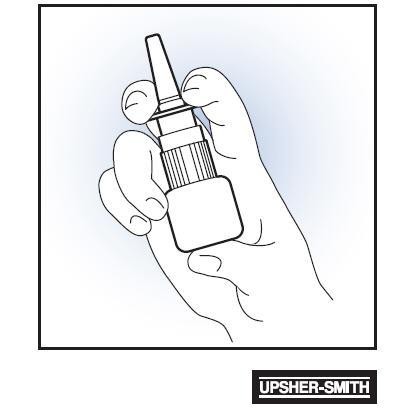
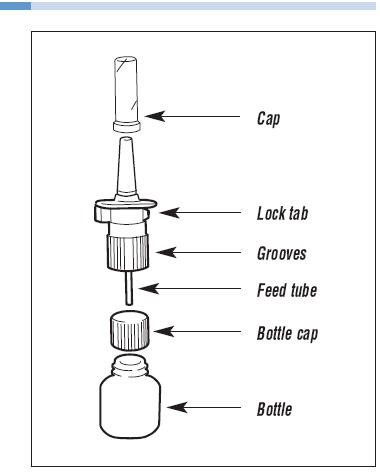
Patient Information
Fortical® [fōr-tǐ-kǎl]
calcitonin-salmon (rDNA origin)
Nasal Spray
Read the Patient Information that comes with Fortical® Nasal Spray before you start using it and each time you get a refill. There may be new information. This leaflet does not take the place of talking with your doctor about your medical condition or your treatment.
What is Fortical® Nasal Spray?
Fortical® Nasal Spray is a prescription medicine used to treat osteoporosis in women, who went through menopause (postmenopausal women) at least 5 years ago.
Fortical® Nasal Spray contains calcitonin salmon, a man-made protein that is similar to a protein occurring in the human body. When you spray Fortical® Nasal Spray into your nostril, it is rapidly absorbed by the blood vessels lining your nasal passages. It then travels into your bloodstream and on to your bones where it has been shown to slow down bone loss at the spine. Slowing down bone loss, while new bone building continues, helps to increase bone mass at the spine.
Fortical® Nasal Spray is taken with calcium and vitamin D supplements recommended by your doctor, to help slow down further bone loss. If you are not getting enough calcium and vitamin D in your daily diet, your doctor may recommend a calcium or vitamin D supplement. The amount of calcium and vitamin D needed each day can vary from person to person. Most people generally require at least 1000 mg of calcium and 400 International Units of vitamin D each day. Vitamin D is necessary for your body to use calcium to build bone material. That is why your doctor may have recommended that you add a vitamin D supplement to your diet. It is important to take all the calcium and vitamin D supplements your doctor directs each day.
Who should not use Fortical® Nasal Spray?
Do not use Fortical® Nasal Spray if you are allergic to the calcitonin salmon protein.
What should I tell my doctor before using Fortical® Nasal Spray?
Tell your doctor about all your health conditions, including if you:
- are pregnant. It is not known if Fortical® Nasal Spray can cause harm to an unborn baby if it is used during pregnancy.
- are breast-feeding. It is not known if Fortical® Nasal Spray passes into your breast milk.
Tell your doctor and pharmacist about all the medicines you take, including prescription and non-prescription medicines, vitamins and herbal supplements.
Know the medicines you take. Keep a list of your medicines and show it to your doctor and pharmacist when you get a new medicine.
How should I use Fortical® Nasal Spray?
- Periodic nasal exams are recommended. Your doctor should do a nasal exam before you start using Fortical® Nasal Spray and if you have any nasal discomfort while using it.
- Use Fortical® Nasal Spray exactly as your doctor prescribes it. See the detailed Patient Instructions for Use at the end of this leaflet.
- Before using a new bottle of Fortical® Nasal Spray for the first time, take it out of the refrigerator and let the medicine warm to room temperature. Using Fortical® Nasal Spray directly from a refrigerator without being warmed to room temperature may cause you to have nasal discomfort.
- Before using a new bottle of Fortical® Nasal Spray for the first time, you will need to prime the pump at least 5 times until a full spray is produced. See the detailed Assembly Instructions and Using Fortical® Nasal Spray sections at the end of this Patient Information Leaflet for directions on how to prime a new bottle of Fortical® Nasal Spray and how to properly use Fortical® Nasal Spray.
- One spray in either nostril will give you the right daily dose of Fortical® Nasal Spray. Change (alternate) between using the right nostril one day and the left nostril the next day. Each bottle of Fortical® Nasal Spray contains enough medicine for 30 days of dosing.
- After priming the pump, do not use Fortical® Nasal Spray for more than 30 doses. Even though the container may not be completely empty, you may not get the correct dose of medicine. Safely throw away the empty bottle of Fortical® Nasal Spray after you have used 30 doses.
- If you miss a dose, or forget to use Fortical® Nasal Spray, use it as soon as you can. If it is almost time for your next dose, wait until then to use the medicine and skip the missed dose. Do not use extra medicine to make up for the missed dose.
- If you use too much Fortical® Nasal Spray, tell your doctor.
What are the possible side effects of Fortical® Nasal Spray?
Serious allergic reactions can happen with Fortical® Nasal Spray. See "Who should not use Fortical® Nasal Spray".
Get emergency medical help right away if you have any of the following symptoms of a serious allergic reaction:
- trouble breathing
- swelling of your face, throat or tongue
- rapid heartbeat
- chest pain
- feel faint or dizzy
The most common side effects of Fortical® Nasal Spray include:
- nasal symptoms including: runny nose, dryness, crusting, sores, infection, redness, irritation, itching, tenderness, nosebleed, discomfort across bridge of nose
- back and joint pain
- headache
Tell your doctor if you have any side effect that bothers you or that does not go away. These are not all the possible side effects of Fortical® Nasal Spray. For more information, ask your doctor or pharmacist.
How should I store Fortical® Nasal Spray?
- Keep new, unopened bottles of Fortical® Nasal Spray in the refrigerator, between 36°F to 46°F (2°C to 8°C).
- Do not freeze.
- Keep the bottle of Fortical® Nasal Spray away from light.
- Allow the Fortical® Nasal Spray to reach room temperature before using it and for the first time.
- Tighten the pump securely to the bottle (see Step 3 and 4 in the Patient Instructions of Use - Assembly Instructions). This will help to ensure a good seal between the pump and the bottle.
- After opening a new bottle of Fortical® Nasal Spray, store at room temperature, 68°F to 77°F (20°C to 25°C).
- Each bottle of Fortical® Nasal Spray contains enough medicine for 30 doses. Throw away the empty bottle of Fortical® Nasal Spray after you have used 30 doses.
Keep Fortical® Nasal Spray and all other medicines out of the reach of children.
What are the ingredients in Fortical® Nasal Spray?
Active Ingredient: Calcitonin-salmon
Inactive Ingredients: Sodium Chloride USP, Citric Acid USP, Phenethyl Alcohol USP, Benzyl Alcohol NF, Polysorbate 80 NF, Hydrochloric Acid NF or Sodium Hydroxide NF and Purified Water USP.
General Information about Fortical® Nasal Spray
This medication was prescribed for you by your doctor for a particular condition. Do not use Fortical® Nasal Spray to treat a condition for which it was not prescribed. Do not give Fortical® Nasal Spray to other people, even if they have the same symptoms you have. It may harm them.
This patient information leaflet summarizes the most important information about Fortical® Nasal Spray. If you would like more information about Fortical® Nasal Spray talk with your doctor. You can ask your doctor or pharmacist for information about Fortical® Nasal Spray that is written for health professionals. For more information, go to www.upsher-smith.com or call 1-800-654-2299.
General Information about Osteoporosis
The amount of estrogen produced by a woman's body is greatly reduced after menopause. Estrogen helps to balance bone growth and keep bones strong. When estrogen is reduced, your body may remove old bone cells faster than it replaces them with new bones cells. Bones can become weak and brittle, and more likely to break (fracture). This condition is known as postmenopausal osteoporosis. Fortical® Nasal Spray may increase bone density, but there is no information to show that it decreases the risk of fracture.
Patient Instructions for Use
Assembly Instructions
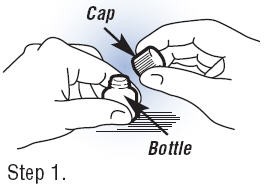
|
Step 1. Opening the Bottle. If your pharmacist attached the pump for you, skip to step 4. Otherwise, set bottle on a flat surface like table or counter top. Hold the bottle firmly while unscrewing cap to avoid spilling any Fortical® Nasal Spray. |
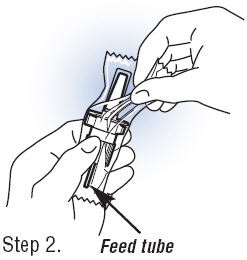
|
Step 2. Unwrapping the Pump. Carefully cut the wrapper with scissors or knife, and tear away from the pump. Be careful not to cut, bend, or touch the feed tube at bottom. |
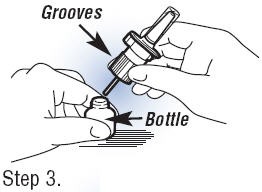
|
Step 3. Attaching the Pump. Hold the bottle on a flat surface (like a table), and screw the pump onto bottle by gripping the grooves of the pump and twisting clockwise until the pump is tightly sealed to the bottle. |
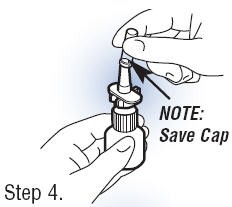
|
Step 4. Removing Cap. To remove the cap from the pump, twist slightly while pulling up. Save the cap to replace after each use. |
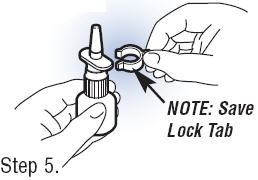 Save the lock tab, and push it back on to the pump after each use to avoid accidentally wasting any Fortical® Nasal Spray
Save the lock tab, and push it back on to the pump after each use to avoid accidentally wasting any Fortical® Nasal Spray
|
Step 5. Removing the Lock Tab. Grasp the lock tab between thumb and forefinger, while holding the bottle on a flat surface. Pull sideways to remove the tab and unlock the pump. |
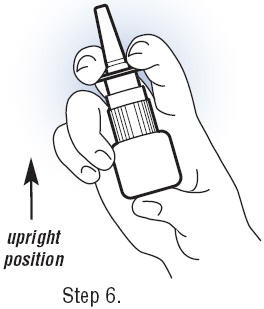
|
Step 6. Prime New Pump Before First Use.
Before you use a new bottle of Fortical® Nasal Spray for the first time, you will need to prime it. This will ensure you get the right dose of medicine each time you use it. After you attach the pump to the bottle, and the pump and bottle have reached room temperature, you should: |
|
|
You only need to prime a new bottle. Do NOT re-prime it before each use.
Using Fortical® Nasal Spray...
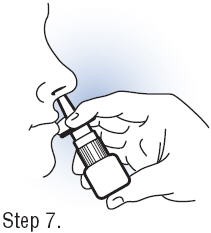
|
Step 7. Using Fortical® Nasal Spray
|
|
|
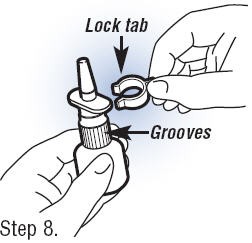
|
Step 8. Replace The Lock Tab After Use. Replace the lock tab to prevent wasting medication by accidently depressing the pump. Simply slide the lock tab on by pushing it sideways against the grooves in the pump. |
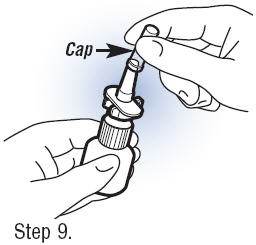
|
Step 9. Replace The Cap.
|
Store Fortical® Nasal Spray in an upright position. Tighten the pump securely to the bottle (see Step 3 and 4 in the Patient Instructions for Use). This will help to ensure a good seal between the pump and the bottle.
Cleaning the Pump. Clean the spray tip by gently wiping it with a clean, damp cloth or tissue. Dry the tip with a cloth or tissue before replacing the cap. Do not submerse the tip or bottle in water.
Upsher-Smith Laboratories, Inc.
Minneapolis, MN USA 55447-4709
www.upsher-smith.com
Toll Free 1-800-654-2299
103001-01
Revised 0609
UPSHER-SMITH
PRINCIPAL DISPLAY PANEL - 2200 IU/mL Carton
Fortical®
calcitonin-salmon
(rDNA origin)
Nasal Spray
200 International Units/dose
2200 IU/mL
REFRIGERATE
UNTIL OPENED
at 36-46°F (2-8°C)
FOR INTRANASAL USE ONLY
30 doses
Each carton contains:
1 × 3.7 mL fill bottle and
1 spray applicator Rx only
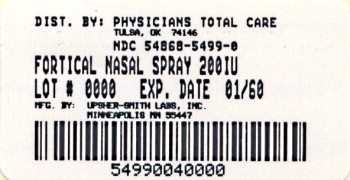
Forticalcalcitonin salmon SPRAY, METERED
| |||||||||||||||||||||||||||||||||||||||||||||||||||||||||||||||||||||||||||